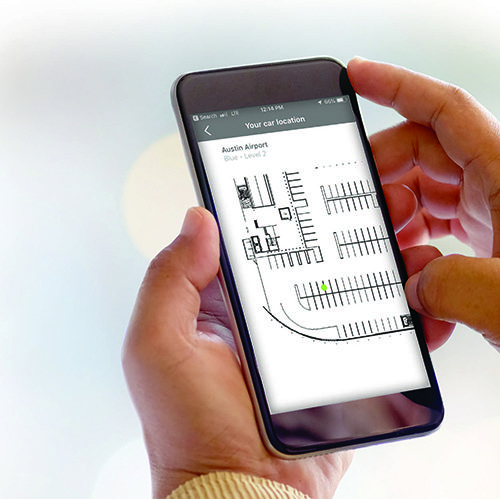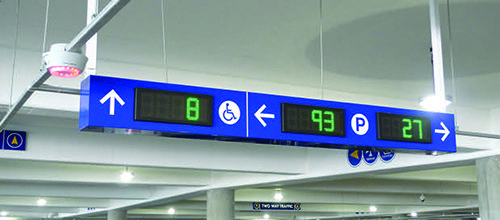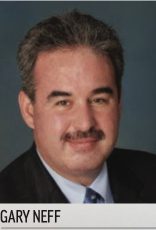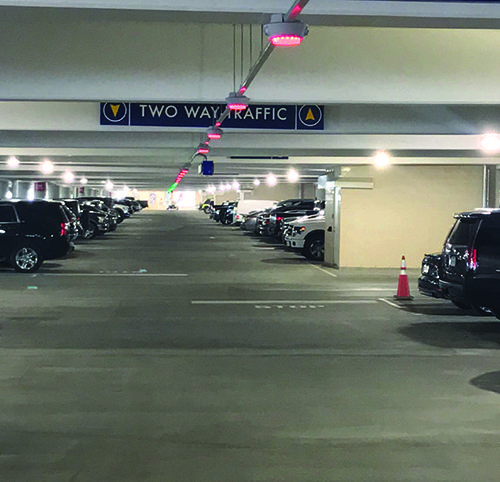Austin, TX, is booming with tech companies galore, a vibrant arts scene and a calendar full of large festivals that attract hundreds of thousands of people to the growing area. Amid the hustle and bustle, executives at Austin-Bergstrom International Airport (AUS) are looking down the road five, 10 and even 20 years to predict passenger needs.
Austin, TX, is booming with tech companies galore, a vibrant arts scene and a calendar full of large festivals that attract hundreds of thousands of people to the growing area. Amid the hustle and bustle, executives at Austin-Bergstrom International Airport (AUS) are looking down the road five, 10 and even 20 years to predict passenger needs.
Seeing the clear need for more parking capacity to keep pace with passenger growth, AUS opted to replace one of its flat surface parking lots with a six-story garage, increasing capacity in that area from 1,050 spaces to 5,800. The airport’s total parking capacity is nearing 18,400 spots (including about 1,475 for employees). The new Blue Garage, which is adjacent to the airport’s consolidated rental car facility, is part of a $250 million project to execute improvements throughout the airport.
The new facility includes long-term parking with a space detection system, a five-story administration facility and upgraded entryways and exits for vehicles. The moving target for the airport is to get ahead of anticipated growth by freeing up valuable real estate and streamlining the parking process for greater passenger satisfaction.
|
facts&figures Project: New Long-Term Parking Garage Location: Austin-Bergstrom Int’l Airport (TX) Size: 6 floors, each approx. 810 ft. wide & 375 ft. deep Garage Capacity: About 1,000 spaces/floor; 5,800 total (when top floor opens) Total Airport Parking: 18,386 spaces, including 1,474 in employee lot Facility Design: PGAL Architects Specs for Space Detection System: Walker Parking Consultants Cameras & Track: Park Assist Installation: Associated Time Instruments Parking Management: SP+ Timeline: Design started in May 2016; construction began in June 2017; first 2 levels opened in Dec. 2018; most of remaining parking opened in April 2019 Key Benefits: More parking capacity; space detection system eases parking process for customers; moving airport administration from terminal to new garage frees up space for passenger amenities; solar panels being installed on roof will provide renewable energy |
“I think this garage will address the overall capacity between our lots and off-airport parking,” says Jerry Dinse, administrator of parking services for AUS. “With this project, the demand for airport parking is covered for at least the next five to 10 years.”
Moving the airport administration facilities into the new multi-level garage freed up space for more lounges, concessions and passenger amenities in the terminal.
The airport engaged PGAL Architects to design the facility and Austin Commercial to build it. In turn, Austin hired Park Assist to provide sensors and accompanying track for the space detection system; and Park Assist subcontracted Associated Time Instruments to link the sensors to the servers. New digital signage was added for the entire length of Presidential Boulevard to improve traffic flow and help drivers passing through the airport perimeter see the availability of onsite parking.
“It becomes frustrating to chase down parking spaces as a garage approaches max capacity,” says Park Assist Chief Executive Officer Gary Neff. “With this technology installed, visitors will know exactly where to find a place to park, and the airport can manage the capacity more tightly.”
Space Detection
The new garage at AUS includes a smart-sensor system that streams images to a video management system while also transmitting data for integrated license plate recognition and occupancy tracking. When a parking spot is occupied, one of the system’s 3,000 cameras will detect that a vehicle is in that space. If all other spaces in the four-vehicle block are also taken, the LED light overhead will turn from green to red (or blue to red for accessible parking spaces).
As long as a vehicle is parked nose in/tail out as directed, the cameras will capture its license plate number for the database. As a result, if a customer forgets where he parked, the software can scan the system for his plate number and indicate which floor he parked on, and what is parked near it for reference. Two kiosks stand ready to assist forgetful drivers.
“There is an algorithm that recognizes the space, and the software has a learning process,” says Ed Lammer, vice president of Operations for Associated Time. “For instance, in the morning the camera learns the difference between dark and light and adjusts accordingly.”

A dedicated onsite server collects the data and sends it to the cloud.
Avoiding Disruption
Before construction of the garage began in June 2017, the team developed a transition plan to route passengers around surface lot that was being transformed, and funnel them into alternate parking locations.
“There’s no way to keep customers from feeling the impact when they’re in the middle of a construction site, but the idea is to minimize it as much as possible,” says Dinse. “We gave notice to our passengers with flaggers, signage and traffic plans to minimize the inconvenience.”
 Installation of the space detection system was less disruptive than facility construction, notes AUS Project Manager Robert Mercado. “The logistics of closing a large parking lot and having the very large cast-in-place concrete structure constructed while maintaining all other parking operations and access to the Terminal Building from the remaining parking areas was a challenge,” he reflects. “Almost all of the thousands of cubic yards of concrete were poured during overnight hours to avoid disruption to airport traffic during the day.”
Installation of the space detection system was less disruptive than facility construction, notes AUS Project Manager Robert Mercado. “The logistics of closing a large parking lot and having the very large cast-in-place concrete structure constructed while maintaining all other parking operations and access to the Terminal Building from the remaining parking areas was a challenge,” he reflects. “Almost all of the thousands of cubic yards of concrete were poured during overnight hours to avoid disruption to airport traffic during the day.”
Dinse notes that the project team met weekly, and the airport has an exceptionally good and open relationship with the contractors. “Given the challenge of doing a massive major construction project in the middle of a parking facility, I think it has been a successful project,” he remarks.

Design & Construction
The Blue Garage is approximately 810 feet wide and 375 feet deep. Lammer puts the size in perspective this way: “Each floor can hold just over five football fields. In other words, it’s the equivalent of 25 football fields, not including the additional five football fields on the roof.”
That’s clearly a touchdown for increasing capacity.
“We chose to include exterior speed ramps instead of internal ramps, which helped us maximize the number of spaces per floor,” adds Dinse. “During the design phase, we were talking about capacity and demands and how we were going to move people. The idea for an external speed ramp made a lot of sense.”

The airport’s “go date” to have the first two floors ready for business before Thanksgiving 2018 created a scramble; but Dinse notes that collaboration between project participants ultimately made it possible. “It was key that the airport and contractors worked together,” he says. “We all worked around-the-clock with multiple shifts to get it done. Austin Commercial really understood the business and made it possible for us to do our job.”
Because the garage was new construction, Park Assist had to wait until the floors were striped to install tracks and cameras for the space detection system. But parking spaces did not need to be empty for crews to install or repair lights. Tracks and lights can be accessed from the center of the lane.
Neff notes that some other parking systems use sensors on the ceiling directly over vehicles.
“Ours is about three-quarters technology and one-quarter implementation,” he says. “Ultrasonic technology is the opposite; it’s more like three-quarters labor and one-quarter technology. In this case, the cameras are installed down the center aisle, which means no customer displacement.”
Another Green Gem
On the roof of the Blue Garage, lean skeletons of canopies provide shade for vehicles. Soon, the canopies will be covered with solar panels. In partnership with Austin Energy, AUS will install 8,100 frameless solar modules with 80 inverters. When completed, the solar roof is expected to generate more than 3.2m kilowatt-hours (kWh) per year.
“For the sixth consecutive year, the airport is 100 percent powered by renewable energy, and we participate in the Austin Energy GreenChoice program,” says Hackett. “Last year, we replaced more than 30 diesel-powered vehicles with electric alternatives.”
The airport’s sustainability achievements are described on the “Green Gems” page of its website. Here, passengers and business partners can see that all electric power for airport buildings is generated by wind turbines. By using reclaimed water, AUS saved more than 35 million gallons of drinking water in 2017.
The airport’s thermal energy storage program allows it to save chilled water during off-peak times for cooling the terminal spaces, and then use it during hotter afternoon hours—reducing electricity usage by 50%. In summer, temperatures in Austin regularly soar into the three-digit range. The drain on power for air conditioning is mitigated by these green efforts.
The forthcoming solar panels on the roof of the new parking garage are one more example of AUS’ environmental pledge to incorporate sustainable principles, utilize climate resiliency best practices and integrate environmental stewardship into all aspects of its culture, planning, development and operations.

Data Tells the Story
Neff says that Park Assist is a parking company focused on the data to build historical information.
“For the consumer, it’s about getting into the garage faster and with less stress. For the airport, it’s optimizing the usage of the garage,” Neff explains. “Many airports will close down their parking when it’s 91% to 93% full. We can bring it up closer to 98%. We’re not just detecting a vehicle; we record the license plate number, evaluate security risks and can change the price of parking depending on where they park.”
While the parking management team uses the system’s cameras to determine if spaces are occupied or available, there are other valuable byproducts of that data. Security monitoring is a big one.

“Installing 1,000 security cameras in a garage is expensive and challenging. But since we’re already seeing everything, we share it with the surveillance system,” says Neff. “We see those benefits as being logical. There are many other things that can be done.”
Accumulated data will serve as a baseline for future predictive models. Mercado counsels other airports that might implement similar systems to consider where the airport service is headed in the future. “It’s important to know that you’re planning for a parking detection system that is up-to-date on technology and functionality to serve the airport customers,” he says.
Dinse agrees that looking into the future is a challenging, but necessary, exercise. “We established a long time ago that when our traffic grew to a certain volume, that would be a trigger for certain expansions,” he explains. “We did not anticipate the phenomenal growth that Austin has experienced, and we blew through those trigger points before we knew it.
“Get started well in advance and anticipate as much as you can,” he advises. “How clear is your crystal ball?”
Neff and the Park Assist team are already crunching the data to develop a historical record and baseline. Information currently being collected is going to tell the story of how AUS customers will continue to drive the movement toward optimized parking, Neff predicts.
“Parking is something people love to hate,” he concludes. “Our job is to help reduce stress getting in and out.”



